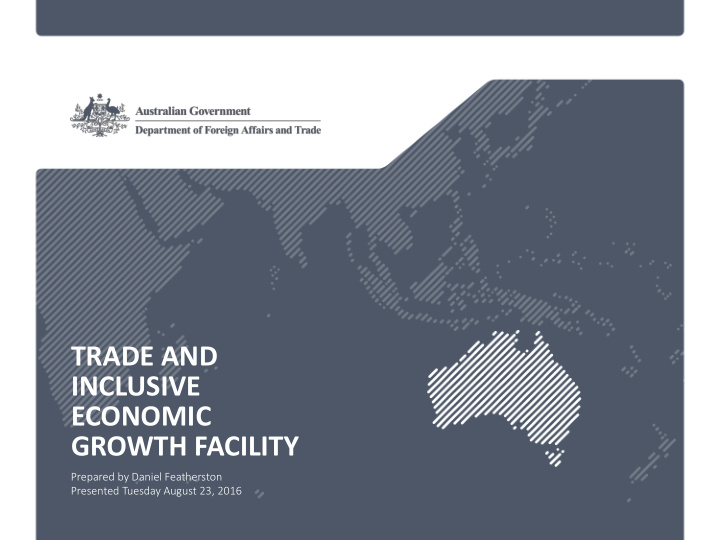



TRADE AND INCLUSIVE ECONOMIC GROWTH FACILITY Prepared by Daniel Featherston Presented Tuesday August 23, 2016
RATIONALE FOR INVESTMENT • The goal and objective of Australia’s Aid Investment Plan the Philippines: 2015-16 to 2017-18 is to accelerate, and build the foundations for, inclusive economic growth. THE FACILITY GOAL • The Trade and Inclusive Economic Growth Facility will help the Philippines achieve sustained and inclusive growth. Trad ade e and d Inclusi sive e Econ onom omic Gr Growth h Facility 2
INDICATIVE OUTCOMES • Reduced barriers to selected trade and investment flows. • Reduced cost of doing business and an improved business environment. • Improved participation in the economy by key vulnerable groups. • Better services by economic agencies. Trad ade e and d Inclusi sive e Econ onom omic Gr Growth h Facility 3
SELECTED STATISTICS 180 The proportion of people 160 below the poverty in the 140 Country Ranking 120 Philippines is 26.3% (first 100 80 semester 2015, from the 60 Philippine Statistical 40 20 Authority). 0 Malaysia Indonesia Philippines Cambodia Laos Singapore Thailand Vietnam Brunei Myanmar Australia WEF The Enabling Trade Index 2014 Ranking WEF The Global Competitiveness Index 2015-16 Rankings World Bank Ease of Doing Business Rankings 2016 Trad ade e and d Inclusi sive e Econ onom omic Gr Growth h Facility 4
AREAS OF ENGAGEMENT Five complementary areas of engagement underpin the facility and contribute to this goal: 1. Connecting the Philippines with the global economy - aid for trade. 2. Improving competitiveness and domestic regulatory reform. 3. Better jobs and increasing inclusiveness. 4. Responding to emerging economic issues. 5. Strengthening economic institutions. Trad ade e and d Inclusi sive e Econ onom omic Gr Growth h Facility 5
CONNECTING THE PHILIPPINES WITH THE GLOBAL ECONOMY – AID FOR TRADE Design activities that: 1. Help the Philippines negotiate Free Trade Agreements. 2. Increase exports/imports by Philippine business through improved National Quality Infrastructure. Investigate how we could help: A. Reduce restrictions on foreign investment. B. Improve trade facilitation. C. Liberalise the professional services sector. Trad ade e and d Inclusi sive e Econ onom omic Gr Growth h Facility 6
IMPROVING COMPETITIVENESS THROUGH DOMESTIC REGULATORY REFORM Design activities that: 1. Help implement the Philippine Competition Policy Act. Investigate how we could help: A. Reduce the cost of doing business. B. Reduce unnecessary or inefficient regulation imposed on business. C. In energy policy. D. Other complementary reforms. Trad ade e and d Inclusi sive e Econ onom omic Gr Growth h Facility 7
BETTER JOBS AND INCREASING INCLUSIVENESS Design activities that: 1. Improve the Philippines’ Social Protection Programs including conditional cash transfers. 2. Help economically empower Philippine women. Investigate how we could help: A. In labour market reform. B. Micro, small and medium sized enterprise development. C. Economically empower key vulnerable communities. Trad ade e and d Inclusi sive e Econ onom omic Gr Growth h Facility 8
RESPONDING TO EMERGING ECONOMIC ISSUES Design activities that: 1. Adapt to the priorities of the Philippine administration and policy opportunities that may emerge. 2. Support: • Australia-the Philippines Comprehensive Partnership – Plan of Action. • Australia’s Economic Diplomacy Strategy. • Philippines-Australia Trade Investment and Industry Dialogue. Trad ade e and d Inclusi sive e Econ onom omic Gr Growth h Facility 9
STRENGTHENING ECONOMIC INSTITUTIONS Design activities that will help targeted economic agencies improve their service delivery capabilities by addressing their human resource and organisational development needs. This could involve offering support to agencies that Australia partners with under areas 1 to 4 above. Trad ade e and d Inclusi sive e Econ onom omic Gr Growth h Facility 10
TYPES OF AID ACTIVITIES There will be three main types of activities: 1. Managing Contractor is the aid activity implementer. 2. A third party (i.e. another development partner) is the main implementer, managing contractor provides oversight through a grant agreement. 3. DFAT provides a direct allocation and the managing contractor provides monitoring and reporting services. Each of these will attract a different performance risk. Trad ade e and d Inclusi sive e Econ onom omic Gr Growth h Facility 11
HOW WILL WE IMPLEMENT THIS INVESTMENT? A facility will allow • flexible and responsive arrangements for programming in which we can move quickly and adapt to changing circumstances. • a mix of risks including exploratory activities, short-term interventions, and long-term programming. • iterative management by trial, experience and adjustment. • us to deploy interventions tailored to the specific problems we tackle. • us to consolidate our current agreements into an efficient management structure. • policy coherence through a strategic framework and annual workplans. Trad ade e and d Inclusi sive e Econ onom omic Gr Growth h Facility 12
HOW WILL WE GET THE FACILITY UP AND RUNNING? • A design and implement approach to market. • The managing contractor will help in: - Design (e.g. strategic framework including principles and investment criteria; operations and grants manual; inception plan). - Set-up/Transition-in (e.g. establish the national office, convene the governance committee, design start-up activities). - Implementation (e.g. develop annual work plans, implement and oversee aid activities, review and reflections). Trad ade e and d Inclusi sive e Econ onom omic Gr Growth h Facility 13
NEXT STEPS Approach to market is expected in the next six months. Trad ade e and d Inclusi sive e Econ onom omic Gr Growth h Facility 14
Thank You Questions? Trad ade e and d Inclusi sive e Econ onom omic Gr Growth h Facility 15
Recommend
More recommend